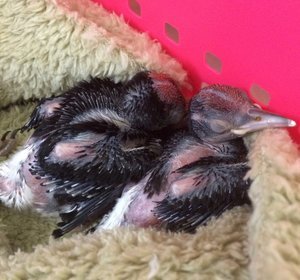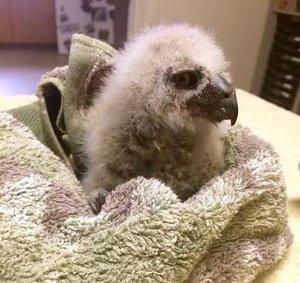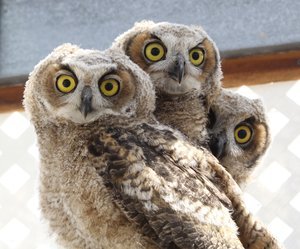
Baby Birds
Before attempting to rescue any wildlife, please observe and consult your local rehabilitation agency.
All wildlife have specific social and dietary needs that cannot be addressed by a non-professional.
It’s always best for a healthy baby bird to stay in the wild with their parents (read below)
Getting sick, injured, or orphaned wildlife to professional care is always in the best interest of the bird or animal.
If the animal in question is in Ventura County, call us directly at 805-649-6884. Leave a message if we are unable to answer immediately; we will return your call as quickly as possible.
If you are not in our area or are unsure who to call, please use Animal Help Now to find your local rehabilitation agency.
If You Find a Baby Bird
I have found a baby bird, what do I do?
Do not attempt to raise a baby bird yourself. All native birds are protected by the Migratory Bird Treaty Act and keeping them for any period of time without a permit is illegal.
Possession of a baby bird can and will result in imprinting, malnutrition, starvation, illness, and/or death.
Imprinting is an irreversible social psychological disorder in animals that occurs when humans try and raise them. When a baby bird is fed/taken care of by a human when it is four to six weeks old or younger, the bird will no longer associate with or recognize its own species. Imprinting is not equal to domestication. If you find yourself caring for a baby wild bird, you may think the bird is thriving because it's alert, eating, and seems to be "fine," but it may have some serious health problems and imprinting may have already occurred. When imprinting occurs, the bird will never be able to feed itself, mate or reproduce in the wild and therefore would never survive in the wild if released. By keeping a wild bird and unintentionally or intentionally imprinting it, you sentence it to a life in captivity or worse. Imprinting is one of the most common "injuries" but it is also one of the most preventable. We strive to give every bird the best chance at survival in the wild, which means having to put aside our natural instinct to nurture it and do the right thing by getting them to professional care. Three of our education ambassadors are imprinted birds, their chance to remain wild was taken from them by humans who were probably trying to help them but were unaware of the possibility of imprinting them.
Fledgling on the ground
ALWAYS observe before interfering with any wildlife. This is especially important for baby birds. When birds are fledging (leaving the nest and learning to fly), they are often on the ground for anywhere from one to five days typically, so it’s actually perfectly normal for them to be on the ground, often looking very vulnerable. During their time on the ground, baby birds may be walking, hopping, and flapping. They’re also learning other things like foraging for food and identifying and avoiding predators. Most fledglings have feathers, their eyes are open and they will usually try and flap away from you! Bird parents have strong instincts to continue to care for their young even after they have flapped out of the nest. So before you scoop up a bird, watch for a parent from a distance as the parent won’t return if you are standing next to their young. If you see the parents, the best thing to do is leave the fledgling alone!
Hazards
There will always be hazards for baby birds, regardless of what type of environment they live in - cats, dogs, kids, cars, etc. If none of these are present near the fledgling, leave the bird alone. If the fledgling is in a perilous place, such as on a sidewalk or in the street, you can pick up the bird by the body and gently move them to a nearby tree or shrub. Keep pets and children away from the bird until they are able to fly away.
If you believe the bird is a nestling and was displaced from the nest (not yet ready to fledge) first try and find the nest. If you can see the nest and can put the nestling back in it, this is the best option. Despite the popular myth, most birds do not have a developed sense of smell and cannot detect a “human scent.” Bird parents will not abandon young if placed back in the nest. If you can’t reach the nest, try placing the nestling in a small container such as a strawberry basket or cardboard box lined with leaves or grass free of fox tails and attach it as best you can to the tree or bush nearest where the bird was found. Corvids (Crows, Ravens and Jays) are an exception to this rule because they recognize man-made objects and will avoid them. Replace them in the nest or simply move them to a safer place nearby. Below is a small breakdown of the difference between fledglings and nestlings:
Hatchling
- Eyes closed.- Wisps of natal down on body.
Nestling
- Eyes open.
- Primary feathers (also called pin feathers) pierce skin, they look like blue tubes sticking out of the skin.
- Bird is alert, stretches wings and legs.
Below are all examples of nestlings — not ready to fledge — should not be on the ground.
Fledgling
- Can flutter and hop from branch to branch, fully feathered, but has short tail and wings, leaves the nest.
- May leave nest and not return, are still fed by the adults in nearby trees or on the ground if the young have not yet mastered flying.
Below are all example of fledglings — they will resemble their adult versions but feathers will be slightly different.
How do I know if the bird is injured?
The majority of fledglings on the ground are uninjured. Again, observe before taking action. If they are flapping their wings, is only one extending? Are they walking? Is there blood? Not flying does not necessarily mean injury.
If you know a bird has been caught by a cat, get it to a wildlife rehabilitator immediately — cats have a bacteria in their saliva and claws that is deadly to birds if not treated immediately.













